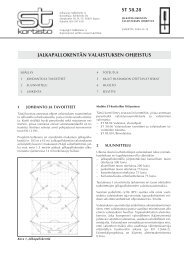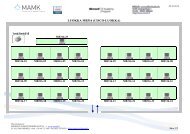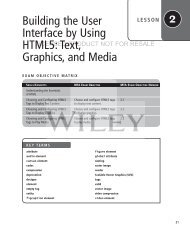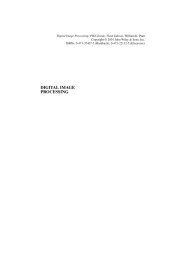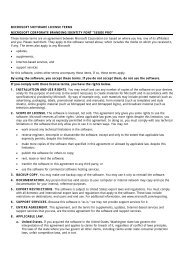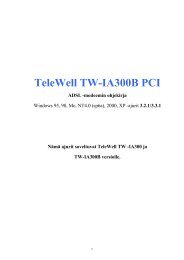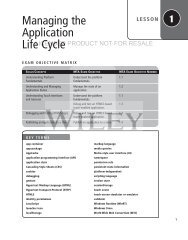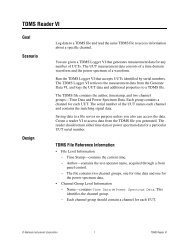Building the User Interface by Using HTML5: Organization ... - server
Building the User Interface by Using HTML5: Organization ... - server
Building the User Interface by Using HTML5: Organization ... - server
Create successful ePaper yourself
Turn your PDF publications into a flip-book with our unique Google optimized e-Paper software.
72 | Lesson 3<br />
TAKE NOTE<br />
*<br />
The menu element was<br />
deprecated in HTML<br />
4.01 but has been redefined<br />
in <strong>HTML5</strong>.<br />
<strong>HTML5</strong> also uses <strong>the</strong> menu element, which presents a list (or menu) of commands, usually<br />
with buttons. The W3C prefers that you use <strong>the</strong> menu element only for context menus, lists<br />
of form controls and commands, toolbars, and similar items. The <strong>HTML5</strong> menu element is<br />
not widely supported <strong>by</strong> browsers as of this writing.<br />
LICENSED PRODUCT NOT FOR RESALE<br />
CREATE AN ORDERED LIST<br />
GET READY. To create an ordered list, perform <strong>the</strong> following steps:<br />
1. <strong>Using</strong> an HTML editor or app development tool and a Web browser, enter <strong>the</strong> following:<br />
<br />
<br />
<br />
<br />
Desktops<br />
Laptops<br />
Tablets<br />
Smartphones<br />
<br />
<br />
<br />
2. Save <strong>the</strong> file as L3-OrderedList.html and view it in a Web browser.<br />
3. To change <strong>the</strong> initial markers to capital letters, insert type="A" in <strong>the</strong> tag,<br />
like this: <br />
4. Save <strong>the</strong> file and view it in a Web browser. Do <strong>the</strong> list items now start with A, B, C, and D?<br />
5. To start list numbering at 5, insert start="5" in <strong>the</strong> tag. Replace <strong>the</strong> current<br />
tag with this: <br />
6. Save <strong>the</strong> file and view it in a Web browser. Do <strong>the</strong> list items now start with 5 and end<br />
with 8?<br />
7. Close <strong>the</strong> file, and <strong>the</strong>n leave <strong>the</strong> editing tool and Web browser open if you continue<br />
to <strong>the</strong> next exercise during this session.<br />
■ Choosing and Configuring <strong>HTML5</strong> Tags for Input and Validation<br />
THE BOTTOM LINE<br />
Developers use Web forms as <strong>the</strong> interface for collecting information from Web site and<br />
client application users. HTML input elements serve to build a form’s interface and ensure<br />
that information is collected from users consistently. Validation ensures that <strong>the</strong> entered<br />
information is in <strong>the</strong> correct format and usable before sending <strong>the</strong> data to <strong>the</strong> <strong>server</strong>.<br />
In HTML, input and validation apply to forms. A Web form is a Web page that provides<br />
input fields for a user to enter data, which is sent to a <strong>server</strong> for processing. From <strong>the</strong>re, <strong>the</strong><br />
information is stored in a database or forwarded to a recipient.<br />
Web forms are used as <strong>the</strong> interface for many different tasks:<br />
• To log in to a Web site, <strong>server</strong>, or network<br />
• To collect contact information, such as name, email address, phone number, and mailing<br />
address<br />
• To sign up for emails or newsletters from an organization



